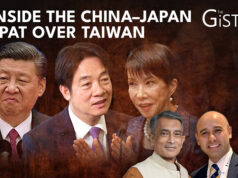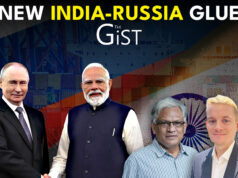What can one expect from the visit of Prime Minister Narendra Modi to Washington, where he is expected to have dinner with President Donald Trump and his team February 13?
Professor Chintamani Mahapatra, Founder and Honorary Chairperson of Kalinga Institute of Indo-Pacific Studies, is one of India’s foremost International Relations experts. Formerly Pro-Vice Chancellor and Professor of American Studies at the school of International Studies at JNU, New Delhi, he’s also the Editor of India Quarterly, the Flagship Publication of Indian Council of World Affairs.
In this interview with The Gist, Prof. Mahapatra explains why he believes that the India-U.S. strategic relationship is likely to be strengthened during President Trump’s second term, despite a few irritants and Trump’s mercurial personality.
Some key takeaways from the discussion:
• Prime minister Modi’s visit comes at a time of global instability, with ongoing wars in Ukraine and West Asia.
• The global economy is struggling, making economic and trade discussions crucial.
• India remains the world’s fastest-growing major economy, and the US prioritizes economic partnerships.
• Modi’s visit aims to strengthen the India-U.S. strategic partnership, particularly in defence, security, and trade.
Expectations:
• Managing differences that arose during the Biden administration.
• Reviving and advancing the strong rapport built between with Modi during Trump’s first administration (Trump 1.0).
• Strengthening defence and security cooperation, particularly in the Indo-Pacific.
• Ensuring freedom of navigation and regional stability amid tensions in the Indo-Pacific.
• Expanding economic ties and ensuring continued bilateral growth.
Deportation of Illegal Indian Immigrants
• India has agreed to accept only those migrants who are confirmed to be Indian citizens.
• The Indian government’s stance is to uphold legality and not support undocumented migration.
• This could create a positive impression with the Trump administration, showing India’s willingness to cooperate on immigration issues.
• Verifying identities of deportees remains a challenge, as many individuals may claim Indian heritage but not be Indian citizens.
Strength of India-U.S. Relations
• The Indian government is optimistic about the Modi visit and its outcomes.
• Personal chemistry between Modi and Trump is strong, which may help in smoothening ties.
• The Indian-American diaspora plays a crucial role in strengthening relations by holding influential positions in business, politics, and academia.
• Indian-origin officials in the U.S. government help bridge understanding between the two nations.
The China Factor
• There are rumours of a potential trade deal between Trump and Xi Jinping.
• A U.S.-China agreement could impact India’s strategic and economic positioning. But such an agreement is unlikely for now.
• India carefully balances relations with both the US and China to avoid conflict.
• The U.S. and China are in competition for global leadership, which affects the geopolitical landscape.
Continuity Rules
- Despite changes in leadership, key collaborations in technology, defence, and trade are expected to continue.
• Bipartisan support in the U.S. ensures stable India-U.S. relations, regardless of political shifts.
• Former President Joe Biden’s NSA Jake Sullivan’s visit to India as his last port of call indicates continuity in strategic cooperation.Challenges
1. Trade & Tariffs – Disagreements on trade policies, tariffs, and market access remain unresolved.
2. Khalistani Extremism – India is concerned about pro-Khalistan elements operating in the U.S. and wants stricter action.
3. U.S. Commission on Religious Freedom Reports – India finds them biased and misleading.
4. Misconceptions on Indian Immigrants – Narrative that Indian professionals take away American jobs, despite their significant contributions.
5. U.S.-Russia Relations – India’s continued engagement with Russia could cause friction with the U.S..
Opportunities
1. Technology & Defence Cooperation – Stronger collaboration in advanced tech and defence systems.
2. Economic Growth – Strengthening trade ties and investment opportunities for both nations.
3. Strategic Partnership in Indo-Pacific – A shared vision to counter China’s growing influence.
4. Indian Diaspora Influence – Leveraging the Indian-American community’s political and business influence.
5. QUAD Alliance – Continued engagement in the Quad (India, U.S., Japan, Australia) to enhance regional security.
Future of the QUAD
- The QUAD remains a strategic priority, with the U.S. and India committed to its growth.
• Trump’s first administration played a key role in reviving the QUAD, and it is expected to remain active.
• QUAD is not just about countering China but also focuses on broader regional security and economic initiatives.Conclusion• Modi’s visit to the U.S. presents a major opportunity to strengthen India-U.S. relations.
• Despite challenges in trade, security, and immigration policies, the overall outlook remains positive.
• Both nations aim to continue their strategic partnership, focusing on defence, trade, and regional stabilityWatch the full interview here
In a career spanning three decades and counting, Ramananda (Ram to his friends) has been the foreign editor of The Telegraph, Outlook Magazine and the New Indian Express. He helped set up rediff.com’s editorial operations in San Jose and New York, helmed sify.com, and was the founder editor of India.com.
His work has featured in national and international publications like the Al Jazeera Centre for Studies, Global Times and Ashahi Shimbun. But his one constant over all these years, he says, has been the attempt to understand rising India’s place in the world.
He can rustle up a mean salad, his oil-less pepper chicken is to die for, and all it takes is some beer and rhythm and blues to rock his soul.
Talk to him about foreign and strategic affairs, media, South Asia, China, and of course India.




